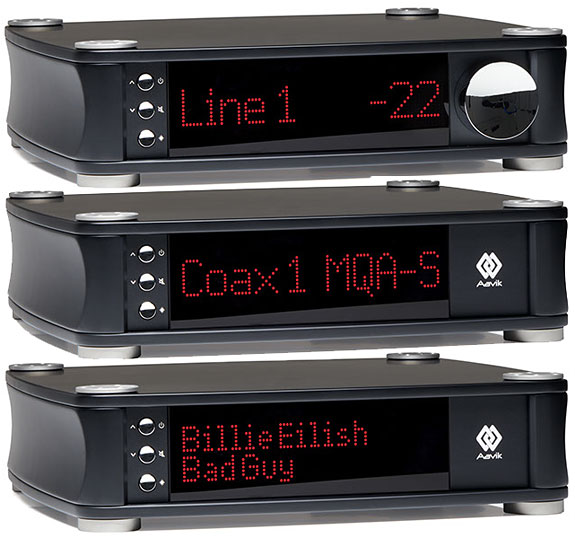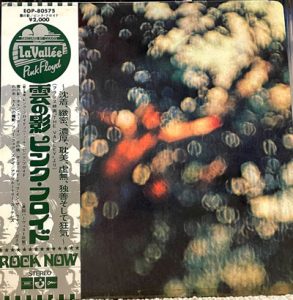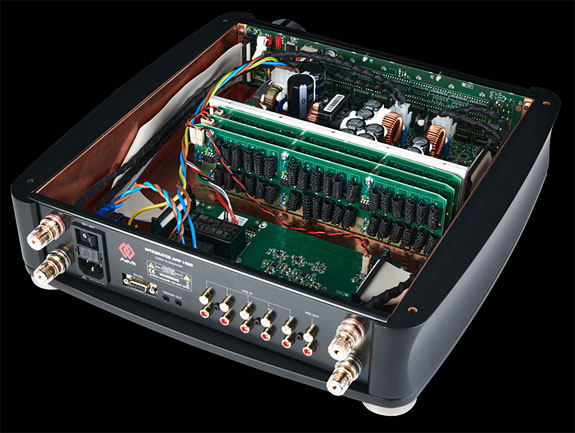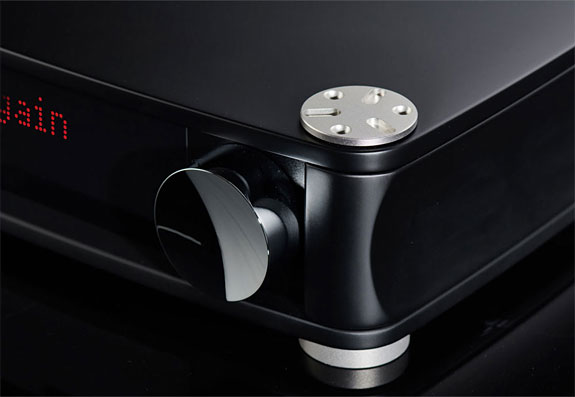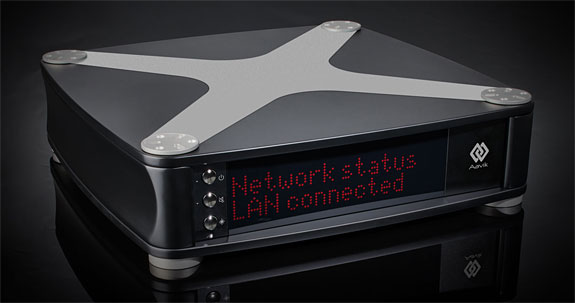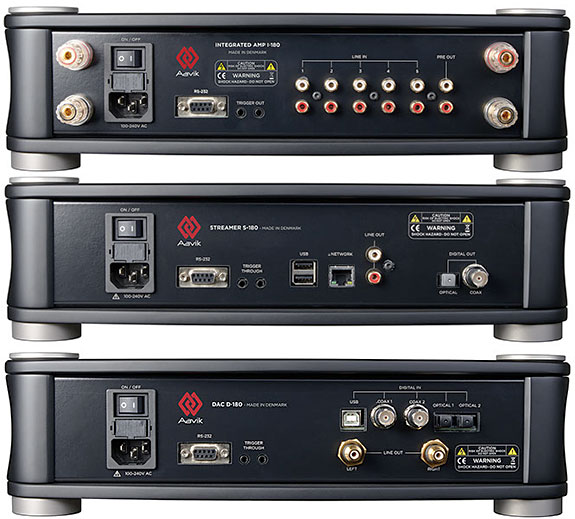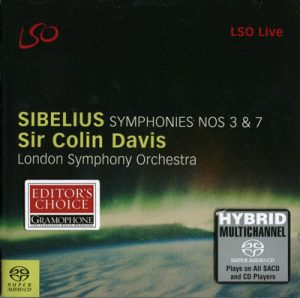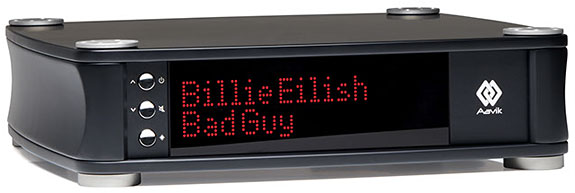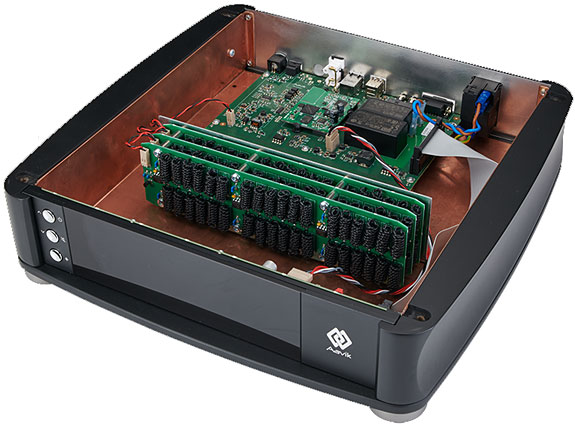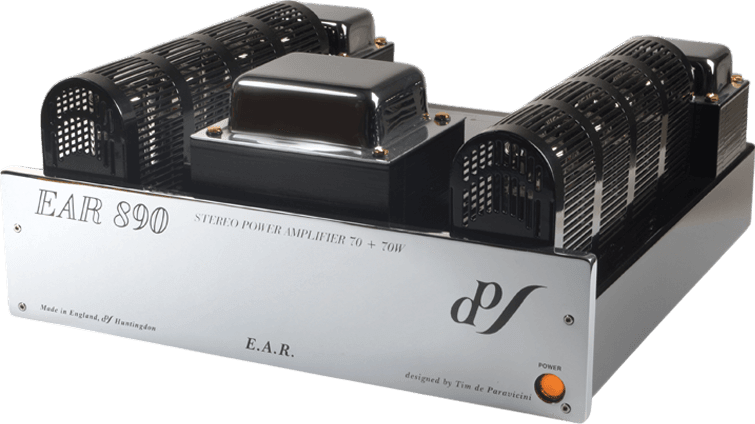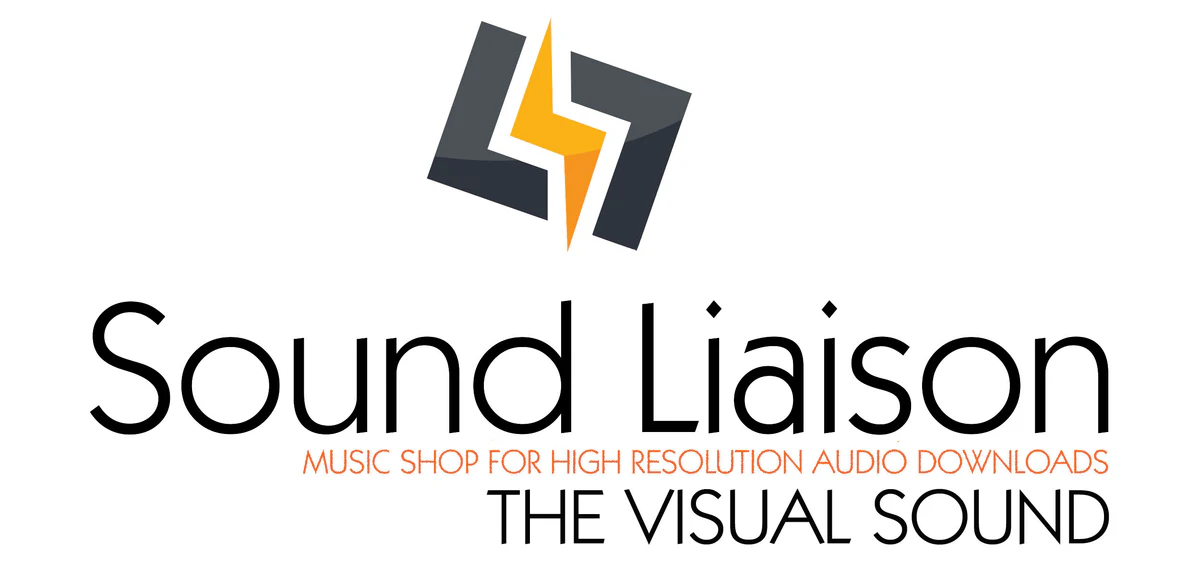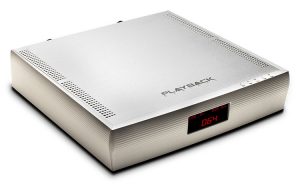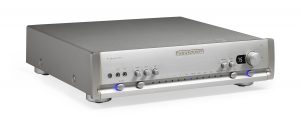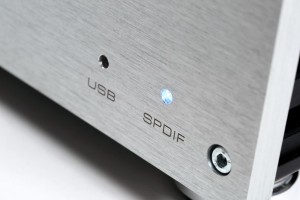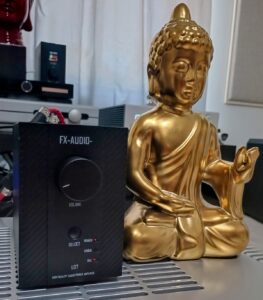A symbiotic sonic relationship... for your listening pleasures.
With this article, Positive Feedback continues its content-sharing relationship with Enjoy the Music where Tom Lyle shares his thoughts on the Aavik Acoustics I-180 Integrated Amplifier, D-180 DAC, And S-180 Streamer / Network Player.
Dr. David W. Robinson, Editor-in-Chief
The Danish high-end audio manufacturer Aavik was nice enough to send me three components from their entry level-line. I call this gear "entry-level" not because it is a system priced for those new to the exciting world of high-end audio but because they are the least expensive components in Aavik Acoustics' 180 / 280 / 580 line.
I did not know the price of these three components when they arrived at my home for review. On looks alone, I assumed that they would cost much more. About halfway through the review period, I peeked inside the cabinet of this integrated amplifier. Its innards looked as if they were constructed by an engineer but also by a visual artist. Its complex yet very neatly arranged interior was impressive.
During my audition of all three components, I determined that their display and intelligent functionality belied their relatively low price. One minor nit I have to pick is Aavik's decision to use a generic Apple remote for these three components rather than design one of their own. Although the Apple remote is functional, by its nature, it does not add to the intangibles that often improve the user experience, and in this case, not regret spending nearly $30,000 for the three components.
I was told by Igor Kivritsky, who is in charge of Aavik's North American distribution told me that rather than design a remote, Aavik "focused all their resources on developing these first," but that an Aavik universal remote is will be available later this year. I would hope that the currently provided remote wouldn't influence one's purchasing decision, but If I were to acquire any or all of these Aavik components, I'd insist on receiving the new Aavik remote when it becomes available.
I-180 Integrated Amplifier
It seems as if we have gotten to the point where Class D amplifiers are almost universally accepted. Although there will always be holdouts, those are usually audiophiles who were disappointed when they heard an early Class D model. Some of these were obviously marketed before they were ready for primetime. But that was quite a long time ago.
The I-180 sounds nothing like those early Class D amplifiers yet retains all the advantages of using this switching circuit, very high efficiency. In addition, it generates little heat and thus little or no heatsinks, a much smaller size.
Aavik used the UMAC amplifier technology developed to surpass the sound quality of other recent Class D amplifiers. This newer circuit focuses on two areas of modular amplifier design; the first is PWM (pulse width modulation) generation is made with sine wave modulation instead of triangle modulation, which has been used for quite some time. This PWM lowers high-frequency noise by eliminating "sharp corners" and needs much less filtering at the output. It also leads to an improved damping factor and thus better speaker control.
In addition to using sine-wave modulation rather than triangular modulation, the Aavik uses "advanced dual mixed-mode feedback" that has been previously used only in the best linear amplifiers. Not only does the I-180 use these two advances in module amp design, but Aavik also uses a volume control that uses what they call an "inverted, virtual GND amplifier technology, which they claim provides the best stability. Providing the lowest signal-to-noise ratio with powerful feedback damps the signal to a very low gain enables it to preserve the full signal regardless of the volume setting.
All three components reviewed here have a giant red LED display that spans from the bottom to the top of the cabinet, allowing one to read this display from across the room with ease. Another nice feature of these components is that I heard no difference whether I stacked the three cabinets atop each other or placed them on different shelves. Their gloss black front panel with a single knob on the right and a few push buttons on the left gave the cabinets a spare, modern-looking appearance.
This relatively small integrated amplifier packs lots of horsepower under its hood. At 300 Watts per channel, it had no problem whatsoever driving my rather large Sound Lab Majestic 545 full-range electrostatic speakers. I usually drive them with a Pass Laboratories X250.8 solid-state power amplifier, and its signal is fed by a tube-powered linestage, the Nagra Classic Tube Preamp.
I feel as if I could write a dissertation explaining the differences in sound quality that I heard between these two methods of powering my system. However, I became accustomed to the sound of the Aavik I-180 in place of my amp/preamp reference rather quickly. The I-180 had a muscle-amp demeanor, and this was very impressive, as its low-frequency prowess was easy to spot. Its pitch-specific, bottomless bass response, combined with extremely quick transients, made listening to this amplifier a blast.
I thought this was a perfect time to listen to my Japanese pressing of the Pink Floyd LP Obscured By Clouds that I still had it lying about from when I was recently geeking out, comparing it to the remixed version on the recently released double CD ObfuscAtion (sic), part of the Early Years box set.
I spun the record on a Basis Audio V turntable with a Top Wing Suzaku "Red Sparrow" cartridge mounted on a Tri-Planar 6 tonearm. The turntable's AC was connected to an outboard power supply and speed controller. This analog front-end ran through a Pass Labs XP-17 phono preamplifier.
This album mixes what most would consider a bridge between early and later period 'Floyd. Also, most would consider it an excellent recording, which is surprising, primarily due to it not being recording at Abbey Road, their usual studio of choice, but instead Strawberry Studios, outside of Paris.
I wasn't prepared for the amount of low-end heft that this integrated amplifier possessed. I should have, as this was a 300-Watt Class D amplifier, after all. Roger Water's bass guitar and Nick Mason's drums were reproduced with a sound with a pitch-specific, extended-sounding bass that wasn't one of the qualities that I usually ascribe to this recording. Roger Water's bass guitar, combined with the thud of Nick Mason's kick drum, added to the pace and rhythm of the album, making me bob my head along with the music, which wasn't something I usually did with many Pink Floyd albums.
I was shocked this album sounded so good, as I recently listened to the remixed version on CD, yet the I-180 seemed to narrow the gap between this and what I assumed was the crisper sound on the newly remixed version. This narrowing was not because it lessened the difference between the two versions but esthetically brought them closer together. Because of this, I can't imagine why the band seemed to think this album needed remixing. In addition, the space that the I-180 seemed to create between the instruments made it easier to hear the difference between settings on Roger Water's bass guitar and different recording techniques used on the drums on each track.
On this album, there are many tracks where Pink Floyd plays like an actual rock band, even coming close to hard rock in some ways, such as the second song on the first side, "When You're In…". Mason hits the snare drum harder on this track than I ever heard before, and "The Gold It's In The…", which appears two cuts later, has actually been covered by some heavy metal bands. The I-180 rendered a very weighty and captivating sound on these tracks. The I-180's deep bass response was one of the best sonic attributes of this integrated amplifier.
During the entire review period, I never sensed that the Aavik I-180 added its own "sound" to the signal, and this clarity made each recording I played able to reveal both the faults and conquests of each. Both macro- and micro-dynamics were reproduced with a very lifelike quality through the Aavik I-180.
My reference amp and preamplifier, which cost more than three times as much as this single Aavik component, were better at differentiating between very similar sounding instruments that contained lots of high-frequency energy. However, after some time spent with the Aavik in my system, this minor complaint became less noticeable, and I became much more appreciative of the very positive traits of this integrated amplifier. The Aavik I-180 had a very detailed sound, yet never sounded etched or in any way overly detailed, depending on the recording, of course.
I often said to myself that I was impressed by this integrated amplifier, that for a Class D amplifier, it sounded excellent. However, as I got further into the review period, I stopped thinking that it was an outstanding Class D integrated amplifier, but simply an outstanding integrated amplifier, especially at its price. I thought this true even after reinstalling it into my system after listening to my reference. Of course, I have heard better, but these amps had much less power and far fewer features than this very good-looking integrated amplifier.
The I-180's front-panel covering red LED display was easy to read even from across the room, and the intangibles of this amplifier, as many settings can be changed by the user. I would have liked a subwoofer output, but other than that, there wasn't much more than I would have liked.
At $7200, I have a bit of trouble calling this integrated amplifier a bargain, but at 300-Wpc, it is a muscle-amp that I doubt one will find one with this much power combined with this good looks anywhere near its price.
Aavik D-180 Analog-To-Digital Converter (DAC)
Aavik claims that their DAC has no "digital signature," which results in music sounding "natural and authentic." Unfortunately, although I have some of my favorite music stored as digital files that sound incredible, I also have many that don't sound so good. As I have some vinyl record albums pressed in the US in the 1970s that sound like crap, I also have many digital files sourced from ripped CDs manufactured in the mid-80s that sound even worse. And like Aavik's I-180, the D-180 didn't hide this fact from me.
On their website, Aavik says that their converter has digital circuits that use "the best" high-frequency parts and that they used "great care" in their setup. They went on to say that they employed "time-aligned, ultra-short, 4-layer printed circuit board traces to "preserve the natural and pristine sound quality of the wide and complex range of different signals."
The D-180's circuits are also fitted with "ultra-low jitter onboard clocks." All DAC circuits are isolated with "13 onboard, separate, low-noise, high-voltage regulators," each feeding only one stage of the signal handling to minimize timing errors. In addition, the USB input is "galvanically isolated," which reduces that amount of noise.
As far as the DAC section of the D-180, its digital inputs are re-sampled and re-clocked before sending it to its output DAC chips. Some might not know what the heck "differential floating topology with virtual ground" is. Still, it isolates the signal path from other sources of ground noise and signal-induced ground modulation. Those terms are new to me, too, but that's when I rely on the saying coined, at least in part, when discussing features like these. Everything matters when designing a high-end component.
In my listening room, the sound quality that resulted from the above was a converter that sounded ultra-transparent to the source, more than any other converter that I heard in or around its price. It seemed as if the only purpose of the D-180 was to read the digital signal that it was fed as accurately as technically possible and convert it into a music signal as accurately as technically feasible. Of course, $7200 isn't chump change. But for the money, I was amazed at what I heard coming from this DAC's analog outputs.
With the D-180 in my system, most of the music that ultimately came from my speakers sounded marvelous. In short, it sounded like music. So, of course, when I played some of the 16-bit/44.1kHz files made from ripping CDs manufactured in the mid-1980s, it wasn't a big surprise that many of them still sounded like crap. And I guess that's a good thing: garbage in, garbage out.
Thankfully, the opposite was also true when I played decent files, such as a rip of the SACD of David Bowie's Heathen on Sony / Columbia that was pressed in Europe. I've always been a fan of Bowie's music, but the material I always liked best and listened to the most was his 1970s output. As time went on, I began to appreciate his later work more and more, almost to the point where there were times when I favored no era more than any other.
David Bowie started working on Heathen before the September 11th attacks, and none of the tracks on the album refer specifically to those events or their aftermath. But in an interview, Bowie said that anyone, especially those like him who lived so close to it as his family did, could not help but be affected by it. So, yes, some of Heathen was influenced by 9/11, even if not explicitly.
I could go on and on about this great album! But this is not a David Bowie review. It's a review of Aavik components! But it was the Aavik D-180 converter that made me think so much of the meaning behind the music. The DSD files of this album is a perfect example of one reason I appreciate having a high-end audio system—capturing the gestalt of real instruments in a real space used to be the mantra of many audiophiles, but an audiophile like myself hardly listens to only those types of recordings that would be able to demonstrate that feature.
So, if a component can't sort out a multi-track studio recording such as this one where David Bowie plays all the instruments on some tracks, it need not apply as a resident in my system. The D-180 did an excellent job at interpreting the intentions of David Bowie on this album when considering its price, which made this DAC even more impressive.
Often, I have trouble reviewing a digital converter in the same way as reviews done with other audio components. Discussing frequency extension, transients, etc., isn't the only criteria I'm listening for when auditioning a DAC. If a DAC is reading the files transparently, then those traits should be the responsibility of the recording. Nevertheless, those traits are often a result of the skill of the analog section of the DAC, much goes on electronically before the signals get to that point. But I'll admit that how a converter manages to create the signal that passes through the analog section is often a mystery to me!
A converter as good as the D-180 obviously must have a digital section where it can get out of the way to the point where it makes me believe that the signal has lost nothing in the conversion process. How a DAC does this is approached in different ways by different designers. A converter must act as an electronic magician of sorts, using its sleight of hand as it somehow can take a series of 1s and 0s and turn them into what I can then believe is an exact replica of what was encoded but is now a soundwave that can affect me emotionally. The Aavik D-180 reproduced the tracks on Heathen, sometimes a very complex recording, with layers of instruments and vocals, and create a sonic landscape that let me into David Bowie's headspace.
Within my system, the Aavik D-180 was up against some stiff competition. My reference DAC costs more than two and a half times the price of the D-180. Last month I reviewed in Enjoy The Music a two-chassis converter that cost almost five times its price! Yet, I didn't quickly listen to the Aavik D-180 for a bit and returned to my reference as soon as I could. The reason I didn't was that there were many similarities between the Aavik converter and those other more costly components.
For example, my reference converter and the very pricey converter I recently reviewed can impart a dynamic distance between instruments—they can sonically separate two or more instruments, sounds, or voices that are the same volume and in the same area of its soundstage. Although not as pronounced, the Aavik D-180 had this same attribute as the other converters. The D-180 (and the I-180 integrated amplifier) sounds a little on the dark side of neutral. Still, given a choice, I'd rather have this slight lessening in the upper treble than the opposite, as a digital component that leans toward being bright. The same goes for a Class D amplifier, as often the highest treble isn't its best quality. Of course, if I wasn't such an audio snob, I might not have noticed this characteristic.
More than once, during the D-180's stay, I played a DSD file of Sir Colin Davis's reading of Sibelius' Symphony No. 7 on the London Symphony Orchestra's label, LSO Live. I've previously used this symphony as a musical example, mostly because I like it so much. It also happens to be a profoundly transparent recording or an orchestra. This one-movement symphony is Sibelius' last. Other than his Symphony No. 4, I feel that it is the most modern-sounding composition.
Like this symphony, which lasts less than 25 minutes, I'll keep my comments brief only because there isn't much to say about the Aavik's D-180's sound quality. This is a compliment. I've heard this work played through quite a few similarly priced DACs, and the D-180 exhibited no additive flavoring to the sound of this orchestral recording but also very few subtractive faults. For a DAC that costs less than $10k, there isn't much to complain about and much to like.
The LSO's strings on this recording sounded lush and distinctive, and the Aavik D-180 presented the orchestra's right side with a heft that was one of the best I've from a DAC anywhere near its price. The soundstage, also distinctive in its scale and depth, also belied this DAC's price. I've heard better DACs in my system, but they all cost much more than the D-180. I don't think I'd be lying if I called this DAC a relative bargain. A terrific-looking, relative bargain.
I highly recommend the Aavik D-180 as either an addition to one's current system or, better yet, as a part of a complete Aavik system.
S-180 Streamer / Network Player
Aavik's S-180 has what looks like the same great-looking, very well-built cabinet as the other two components reviewed and the same excellent red LED display with characters that are large enough to read from across the room. When I stacked the three Aavik components, they looked stunning; they were an imposing trio of components.
Rather than use the front panel controls of the S-180, it was much easier to use Aavik's iOS "Stream Control App." Using this app, I would often stream directly from Tidal, my service of choice, but one can also use Qobus, Spotify, or any other streaming service one wants. Although, most of my listening through a streamer in this system was sourced from network-connected hard drives attached to the music server in my dedicated listening room. My time spent with the Aavik S-180 was no exception. Audiophiles accustomed to using a USB-hard disk or a USB stick will also be able to do so with the S-180 and those who like to stream from locations such as One Drive, Dropbox, iCloud, etc. These days, the sky's the limit. Literally. Just like most streamers on the market these days.
In our second system, located in a shared space of our home, I either stream music on those hard drives via our Wi-Fi or listen to local internet radio. I did so using Aavik's Stream Control App on an iPad. Since I only had the Aavik S-180 for a while, I didn't take advantage of many of the app's abilities, such as controlling multi-room setups, track sorting, or folder bookmarking. But to be honest, I might not have done those things even if I owned the S-180, as I'm very happy listening to what's on the hard drives or using Tidal. Plus, while I had the S-180 in my systems, I was more interested in its sound quality.
Thankfully, this streamer's sound quality matched many of the other sonic characteristics of the two Aavik components sent to me for review, especially the D-180 converter. The sound quality was best when streaming what I consider "local" sources, such as Tidal, or streaming from the WiFi. This is when I could count on an extended frequency response, a large, drawn-to-scale soundstage, and it could even separate instruments, sounds, and voices from each other with a dynamic distance that injected a greater sense of reality.
Aavik's iOS app on my iPad seemed relatively user-friendly. However, I needed my computer-savvy friend to help me set up this streamer and the app. Those who are more acquainted with using a high-end streaming component will likely have less trouble than I did, as my friend said it was straightforward and even laughed at me a bit because of my naivete in this area. I'm not a Luddite, but somewhat late to the game of streaming and the like.
Aavik says in its literature that the secret to the S-180 streamer's excellent sound quality is due to its audio section. It uses two separate "high-precision, low jitter" clocks. One is for when streaming 44.1kHz based music, the other for 48kHz. They both send a signal to the S-180's internal converter and its S/PDIF coax output. It might sound like overkill, but six separate power supplies feed the different sections of this streamer.
I'd recommend this streamer just on sound quality alone. But, add in its good looks, and especially if one is going to purchase another Aavik component, it's a no-brainer.
Conclusion
There are three series currently available from Aavik: 180, 280 and 580. Aavik claims that they are very similar, but where they differ is the amount of built-in Ansuz noise-canceling technology. I've been told that Michael Børresen, who is in charge of design and development at Aavik, has started an "all-out war on noise." Every one of his products does something to minimize noise whether it's mechanical or electrical. The difference between the 180 to the 280 series is that the 280 gets more Tesla coils and as a result, there is more of Ansuz noise-canceling technology. The 580 series adds a copper chassis and some other premiums, but the heart of the product remains the same. This makes the 180 series an incredible value at $7200 per component.
I highly recommend any of these three Aavik components. My recommendation takes a giant step higher if these components are used together, not only because even a stack of only two of them looks so impressive, but because they seem to form a symbiotic sonic relationship.
What is also amazing is that these Aavik components reviewed here are at the bottom of Aavik's three quality levels; for example, the I-180 is also offered as the I-280 and the I-580. It boggles the mind how good those components higher up in the Aavik product line must sound, and therefore, I can also recommend them. I doubt that the I-180 integrated amplifier, the D-180 digital-to-analog converter, and the S-180 streamer/network player can be bettered by any others that are anywhere their price.
TyI-180 Integrated Amplifier
- Gain: lines 1 - 4 is 5-15dB; maximum input 4.5V RMS, Gain line 5 is 1-11dB; maximum input 6.5V RMS
- Input impedance: 10kOhm
- Preamplifier Output: One pair of RCA output
- Maximum Output: 7.5Vrm
- Distortion, Line Atage: <0,005% (THD at 1kHz, 1V input)
- Output impedance: 50 Ohms
- Volume control: 76 positions in 1dB steps
- Output: Two channels at 300 Watts @ 8 Ohm (600W @ 4 Ohms), Distortion (THD+N): <0,006%, IMD: <0.002%, TIM: <0.008%
- Dimensions: 4" x 15" x 15" (HxWxD)
- Weight: 19.5 lbs.
- Price: $7200
D180 Analog-To-Digital Converter
- Digital: Two BNC S/P-DIF (32 to 192 kHz samples, 24-bit, Two TOSLINK optical (32 to 192 kHz samples, 24-bit, USB fully isolated, UAC 2, asynchronous, USB: PCM 32 - 192 kHz samples, 24-bit, plus DSD 64 to DSD 128
- Distortion: <0.005%
- Output: One pair of RCA output
- Output: 4.5Vrms at 0dB
- Output Impedance: 100 Ohms. Aavik Noise Reduction
- Active Tesla Coils: 36
- Active Square Tesla Coils: 104
- Dither Circuitry: 5
- Dimensions:14" x 15" x 15" (HxWxD)
- Weight: 12 lbs.
- Price: $7200
S-180 Streamer / Network Player
- Streaming: DLNA15
- UPnP AV 1.0
- Output: One pair of RCA line outputs, One BNC S/PDIF (32 to 192kHz samples, 24-bit), One TosLink optical (32 to 192kHz samples, 24-bit),
- Dimensions: 4" x 15.1 x 15.75: (HxWxD)
- Weight: 11.5 lbs.
- Price: $7200
Aavik Denmark
9000 Aalborg
Denmark
45.40.51 14 31
North American Distributor
Hi-Fi Centre
433 Carrall Street
Vancouver, BC
Canada V6B 6E3
604.688.5502
Check out Enjoy the Music for more articles and reviews




